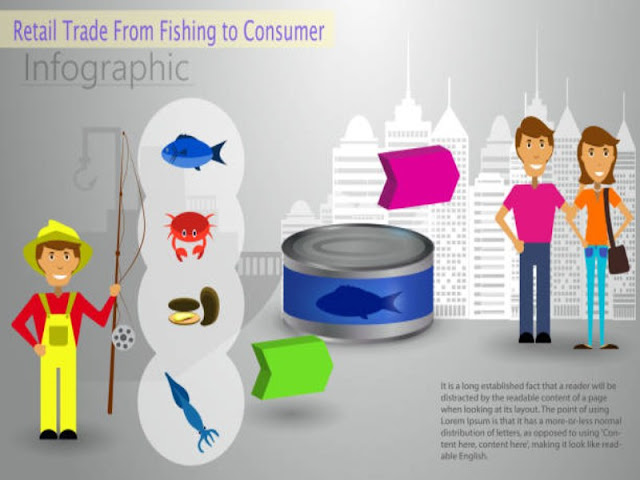Featured
- Get link
- X
- Other Apps
local vs. global marketing

The seafood industry offers a unique perspective on the
dichotomy between local and global marketing. Seafood products, whether sourced
locally or internationally, present various advantages and challenges for
marketing. In this article, we will explore and compare the two approaches,
focusing on locally-sourced seafood products and those from international
markets.
Marketing Locally-Sourced Seafood Products
Advantages:
- Proximity
and Freshness: Locally-sourced seafood products have the advantage of
being fresh and readily available. Consumers often prefer seafood that
hasn't traveled great distances, as it's perceived to be fresher and of
higher quality. Marketing the proximity and freshness of locally-sourced
seafood can attract consumers who prioritize these factors.
- Support
for Local Economies: Marketing locally-sourced seafood products
reinforces the notion of supporting local businesses and economies. This
resonates with consumers who value community connections, sustainability,
and small-scale fisheries. Collaborations with local fishermen and
showcasing their stories can build trust and a sense of community.
- Customization:
Local marketing strategies allow for a higher degree of customization.
Companies can tailor their marketing efforts to align with the local
culture, traditions, and preferences. This personalization can enhance the
consumer experience and create strong brand loyalty.
- Seasonal
Variety: Local sourcing often means access to seasonal seafood
varieties. Companies can market seasonal changes and the limited
availability of certain species, creating a sense of anticipation and
encouraging consumers to explore new options as they become available.
Challenges:
- Limited
Reach: One of the primary challenges of marketing locally-sourced
seafood is the limited geographic reach. The consumer base may be
restricted to the immediate vicinity, which can limit growth potential for
seafood companies.
- Seasonal
Variability: While seasonal variety can be an advantage, it can also
pose a challenge. Seasonal changes in seafood availability may lead to
fluctuations in sales. Companies must effectively communicate these
variations to consumers.
- Pricing:
Locally-sourced seafood is often associated with premium pricing due to
its freshness and sustainable practices. This can be a challenge for
price-sensitive consumers. Balancing affordability with quality is a
marketing challenge for local seafood companies.
- Competition:
In local markets, competition can be intense, especially if multiple
seafood providers vie for the same customer base. Differentiating a brand
and standing out in the local market requires innovative marketing
strategies.
Marketing Seafood Products from International Markets
Advantages:
- Global
Reach: Marketing seafood products from international markets allows
companies to access a broader and more diverse customer base. International
marketing can tap into global demand, reaching consumers in various
regions and countries.
- Product
Consistency: International markets often have the advantage of product
consistency. Consumers can expect specific products year-round, reducing
seasonal variability in sales.
- Economies
of Scale: Sourcing seafood from international markets may provide
economies of scale, potentially reducing production costs and allowing
companies to offer competitive prices. This can be appealing to cost-conscious
consumers.
- Exotic
and Unique Offerings: International markets provide the opportunity to
offer exotic and unique seafood products that may not be locally
available. These products can attract adventurous consumers looking for
new taste experiences.
Challenges:
- Sustainability
Concerns: International seafood sourcing can raise sustainability
concerns, especially if the product originates from fisheries or
aquaculture operations with lax environmental regulations. Marketing
products with questionable sourcing can harm a brand's reputation.
- Transportation
and Environmental Impact: The environmental impact of transporting
seafood products internationally can be a drawback. The carbon footprint
associated with long-distance transportation may conflict with the
increasing emphasis on sustainability.
- Competition:
Global markets are highly competitive. Companies marketing internationally
must compete with established brands and navigate cultural and regulatory
differences. Breaking into international markets can be challenging and
require substantial resources.
- Quality
and Safety Assurance: Ensuring the quality and safety of
internationally-sourced seafood products can be more challenging due to
the distance and various regulatory frameworks. Effective marketing should
address these concerns to build trust with consumers.
Strategies for Effective Local Marketing:
- Emphasize
Freshness and Proximity: Highlight the benefits of locally-sourced
seafood, such as freshness, reduced transportation, and support for local
fishermen and communities.
- Leverage
Local Partnerships: Collaborate with local restaurants, chefs, and
other businesses to showcase locally-sourced seafood in regional cuisine.
These partnerships can help reach a broader audience.
- Storytelling:
Share the stories of local fishermen and their sustainable practices.
Storytelling adds authenticity to your marketing efforts and connects
consumers to the people behind the seafood.
- Seasonal
Promotions: Create seasonal promotions and marketing campaigns to celebrate
the arrival of specific seafood varieties, emphasizing their limited
availability.
Strategies for Effective International Marketing:
- Highlight
Exotic Offerings: Emphasize the unique and exotic seafood products
from international markets, catering to adventurous consumers looking for
novel culinary experiences.
- Sustainability
Credentials: Assure consumers of your commitment to sustainability and
responsible sourcing. Certifications from organizations like the Marine
Stewardship Council (MSC) can add credibility.
- Diverse
Recipe Ideas: Provide a wide range of recipe ideas that showcase the
versatility of international seafood products. Engage with consumers
through cooking demonstrations and virtual classes.
- Transparency and Traceability: Implement traceability systems to assure consumers of the quality, safety, and ethical sourcing of international seafood products. Transparent practices can help build trust.
Conclusion:
Local and global marketing strategies for seafood products
offer distinct advantages and challenges. Local marketing focuses on freshness,
community support, and customization, while international marketing provides a
broader reach and access to exotic offerings. Regardless of the approach,
effective marketing should prioritize sustainability, quality, and transparent
practices to build trust with consumers. Ultimately, the choice between local
and global marketing depends on a company's goals, resources, and target
audience, and both can be successful when executed strategically.
- Get link
- X
- Other Apps

